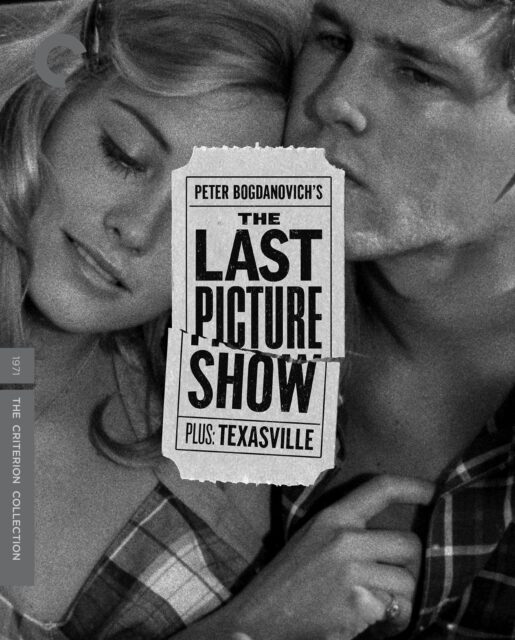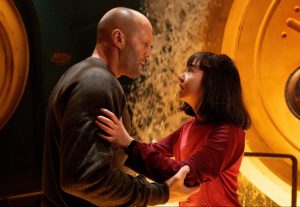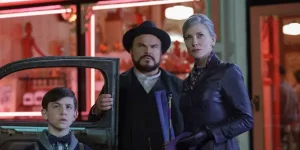
The post Home Video Hovel: The Last Picture Show (plus Texasville), by Scott Nye appeared first on Battleship Pretension.
Even when I first saw it around 2006, just out of high school, Peter Bogdanovich’s The Last Picture Show felt unusual. The new century had been blanketed in teen sex comedies after the success of American Pie, but I never found much to relate to in them. Like a lot of moody young people then, adolescence was fun, but far from a romp of constant deviance. The parties were tepid affairs where the most excitement came from particularly aggressive rounds of Egyptian Ratscrew, and to whatever extent anyone at my Catholic High School was having sex, no one was talking about it. Most of the time, our teenage lives were terrifying, lonely, and, in the wake of 9/11 and the rise of the internet, so much in a state of flux that it felt like the good times were over. We were all listening to music from thirty years ago, watching TV from ten years ago, and reading novels from far before any of that.
The Last Picture Show, based on the 1966 novel by Larry McMurtry, was released in 1971 and takes place twenty years before that in a small Texas town. Its characters are very far from my own experience. But I’d never seen anything that captured that flavor of the high school experience so acutely. Its pervasive melancholy didn’t wind up in outright tragedy the way it did in The Virgin Suicides or Elephant. Its comedy was even more painful, far from the water-hose outlet more mainstream films advertised. The sex was awkward and fumbling and intermittently successful rather than erotic or romantic. It understood that teenagers are proud, fragile, unlikely to fully combust, and prone to attaching massive significance to seemingly-mundane distractions like diners, pool halls, and movie theaters (that those were as frequent a destination for me as they are for Picture Show’s Sonny is our major abiding connection). And they can never seem to say “I love you” to the right people at the right time.
The key arc that all three of its young protagonists – Sonny (Timothy Bottoms), Jacy (Cybill Shepherd), and Duane (Jeff Bridges) – go through is the realization that they have the power to hurt other people. Sonny does it through negligence, Duane through violence, and Jacy through manipulation. Sonny is the most aware of his limitations, but the least capable of doing anything about them. He finds himself content to spend time with much older people – Ruth (Cloris Leachman) for love, Sam (Ben Johnson) for friendship – yet he doesn’t feel the effect they’ve had until after they’ve exited his life, or he theirs. Adolescence is a time of constants until they’re very suddenly not. Duane sees that through Jacy, constantly teasing him with the prospect of leaving until she inevitably does, leaving him adrift, little left to carry on for.
All are encouraged to do harm; Sonny and Duane passively, like most young men are brought up, while Jacy has to contend with her mother’s more overt instructions and the opinion of just about every man who finds her attractive, which more or less accounts for half the town. “You’re not scary enough,” Lois (Ellen Burstyn) tells Jacy to encourage her to seek out better martial prospects than Duane. “Come see me when you’re not [a virgin],” a preppy boy tells her as some kind of come-on. Women always bear the brunt of direct instruction; men wallow and lash out with no constraints at all, and are often given a place to land when they go too far. Jacy has to grow up a lot faster, and by the end, we wonder what she’s gained from doing so.
That question, and many others, were addressed nineteen years later in Texasville, one of several belated sequels to 1970s classics released around that time. The 1990s were a boomer nostalgia factory that argued the 1960s and ‘70s were the most important and vital cultural moment in American history, its every crevice worthy of canonization. Few, if any, of these sequels hit the culture with the same force their predecessors did, if nothing else for the very fact that they acknowledged the inevitable truth nostalgia seeks to bury – life keeps happening. The stars were now older, and they are no longer part of the period you wanted to remember so fondly. They might even be more like you are today.
This is particularly true of Texasville, which though having a twenty-year production gap between itself and Picture Show, takes place more than thirty years after that film – in 1984, only six years before its 1990 release. Texasville also had the benefit of basing itself on a sequel novel, as McMurtry provided the template for a follow-up. The world of Texasville is not the sleepy, dusty small town that represents all the American failures the culture was mourning in 1971; it’s a bustling, thriving small town that nevertheless is facing an invisible collapse. Prosperity is evident in all directions from the big houses to the busy diners to the ostentatious centennial celebration they’re all working towards, but true wealth seems difficult to grasp; everybody’s having fun and no one is happy.
Duane is now fifty, an oil tycoon facing bankruptcy. He’s sleeping with a handful of women in town, too many often for him to track – an early, particularly symbolic scene finds him stuck in the car window of one such woman. There’s some overlap with the rounds his son is making. His daughter has a newborn she has no patience for, and he still has two other much-younger twins sinning their way through summer camp. His wife, Karla (Annie Potts), suspects his cheating and seems halfway towards coaxing him on just so she’ll catch him. Her curiosity only increases now that Jacy’s back in town after traveling the world as an actress of some note, but she doesn’t even recognize Duane when she happens upon him. Somewhere in the midst of this, Sonny’s mental health is deteriorating and he’s locked into a long-gone past.
“Well it’s either laugh about nothing or cry about everything,” Duane memorably says at one point, “and I didn’t feel like crying.”
When he started The Last Picture Show, Bogdanovich was thirty-one, more than ten years older than his principle characters, and still a fair deal younger than the forty-to-fifty-something adults who looked after them. But since Texasville launched its characters forward more than three decades, he was now precisely their age when he came back to them. In the intervening years, he’d lost as much love as he found, alienated wives, friends, and close collaborators, and experienced more failure than success. Hollywood had celebrated and disposed of him faster than most, and he knew something about the impermanence of everything.
Texasville carries this disillusionment, this ability to see the emptiness of the present, the potential of any given moment for rapturous pleasure, and the next day when it’s already a memory. The pervasive attitude of the film is that time and age have made this people a little bit richer, a little bit smarter, but little wiser, and if they were meant to represent a lonely, isolated America in 1971, the friendly, sad America they now show us is in many ways a much more bitter pill to swallow. It failed at the box office and has made little impression ever since.
Viewing the films again on Criterion’s exceptional new UHD release, they now feel more similar than distinct – it helps that Criterion has presented Bogdanovich’s director’s cut, previously only available in full frame on Laserdisc, in its proper aspect ratio, and for the first time in black-and-white. Comparing it to its color theatrical release (also available on this disc), Bogdanovich was right to suspect it plays better this way. It not only aligns well with Picture Show, it provides the caustic edge its incisive tone requires.
The Last Picture Show was previously released on UHD last year as part of Columbia Classics Collection: Volume 3, and as the transfer notes for this release refer to this as coming from Sony, I expect it looks about the same. What I can say for certain, in part because they use the same transfer on the Blu-ray disc included with this release, is that it is a colossal improvement over the one released as part of Criterion’s America Lost and Found: The BBS Story box set from 2010. That was often muddy and indistinct, whereas this is crisp, clear, and provides much more depth and detail in the grayscale range in which the picture operates. Damage is minimal, grain just plentiful enough, and you get the full range of murky blacks and booming whites where appropriate. It’s a dusty town, but now, finally, not a dusty picture.
Texasville fares a little worse, regardless of which cut you choose. Both are presented in HD on a single Blu-ray disc, which, adding up to four and a half hours or film plus a handful of supplements, inevitably hits some compression issues – busier and wider shots have a fair deal of noise, blockiness, and lack of detail. Grain is intermittently well-managed some sometimes too clean. I found the issues noticeable, more so in the theatrical version (black and white is always a little more forgiving towards technical limitations), but not terribly distracting, and especially in an era when streaming is so hit and miss on video quality, I suspect most viewers won’t object to the film being presented this way as a supplement. Certainly, whatever you choose, it’s better than the film’s been served on home video ever.
All the Texasville material – including an introduction and a brief additional segment to the 1991 documentary Picture This: The Times of Peter Bogdanovich in Archer City, Texas, plus a brief interview with Bogdanovich in the booklet – accounts for the only additional material on this release that wasn’t available in the BBS set. All the rest applies to Picture Show. From that set, we get both commentary tracks – on from 1991 with Bogdanovich and several actors; one from 2009 with just Bogdanovich – as well as the rest of Picture This, The Last Picture Show: A Look Back from 1999, 16mm screen tests of the cast and location footage, a five-minute segment from a French TV program in which François Truffaut discusses the New Hollywood movement, and a Q&A with Bogdanovich from 2009.
The best features are the bulkiest; even if Bogdanovich is not always the most dynamic speaker, he’s honest – maybe too honest – about elements of the film that he wished worked better (his slight note of regret over not casting John Ritter instead of Timothy Bottoms always struck me), and he has a degree of melancholy about the film as a whole that I never noticed listening to him discuss his other films. Much of that could probably be chalked up to the personal difficulties he had making it, starting with a reticence to make it at all, and how it’s not one of his most-acclaimed and -loved films.
Between two commentaries and two retrospective documentaries, you’ll inevitably get a lot of repeated and contradictory stories. Much gets lost as myths build up. The myths around this film in particular have in some cases been further complicated by Karina Longworth’s fantastic podcast series on Polly Platt as part of You Must Remember This. Platt was Bogdanovich’s wife when they made The Last Picture Show, though they began separating during its production as he took up with Shepherd, and the podcast – drawn from Platt’s unpublished and incomplete autobiography – makes a compelling case for her being a major unsung creative voice on the film. I highly recommend taking in all of it, noticing where stories diverge, keeping in mind that creative environments are chaotic, collaborative environments in the best of times, where many people bring many ideas, and success – which The Last Picture Show most certainly was – has many fathers. What becomes compelling in taking it all in is less in assigning responsibility than appreciating all the hard work and insight poured into it, and who remained most passionate about it, decades later.
The Last Picture Show has remained a stalwart classic for over fifty years now, one that launched the careers of several important actors as well as its director, and it’s a film greatly improved by considering Texasville along with it. I have so much affection for that film, which has only grown with this new version of it, and I hope it remains as inseparable from the original as this release suggests it should be.
The post Home Video Hovel: The Last Picture Show (plus Texasville), by Scott Nye first appeared on Battleship Pretension.
The post Home Video Hovel: The Last Picture Show (plus Texasville), by Scott Nye appeared first on Battleship Pretension.





